Various Management Theories: Fordism, Toyotaism, and Bureaucracy
VerifiedAdded on 2020/04/21
|6
|2104
|81
Essay
AI Summary
This essay explores various management theories and their applications in modern organizations. It begins with an overview of the core responsibilities of management, including resource allocation and performance monitoring, emphasizing the impact of human resources and group dynamics. The essay then delves into several key management theories, such as Scientific Management, Contingency Theory, Fordism, Toyotaism, and Bureaucratic Management, each offering distinct approaches to organizational structure, production, and employee relations. Scientific Management focuses on efficiency, while Contingency Theory emphasizes adaptability to external factors. Fordism and Toyotaism represent contrasting production models, and Bureaucratic Management highlights hierarchical structures. The essay also discusses the Neoclassical Theory of Management, which integrates human relations into management practices. It concludes by emphasizing the importance of selecting the most appropriate management theory based on organizational context and goals, considering factors such as resource availability and employee rights.

Running head: There is only one best way to manage
‘There is only one best way to manage’
‘There is only one best way to manage’
Paraphrase This Document
Need a fresh take? Get an instant paraphrase of this document with our AI Paraphraser
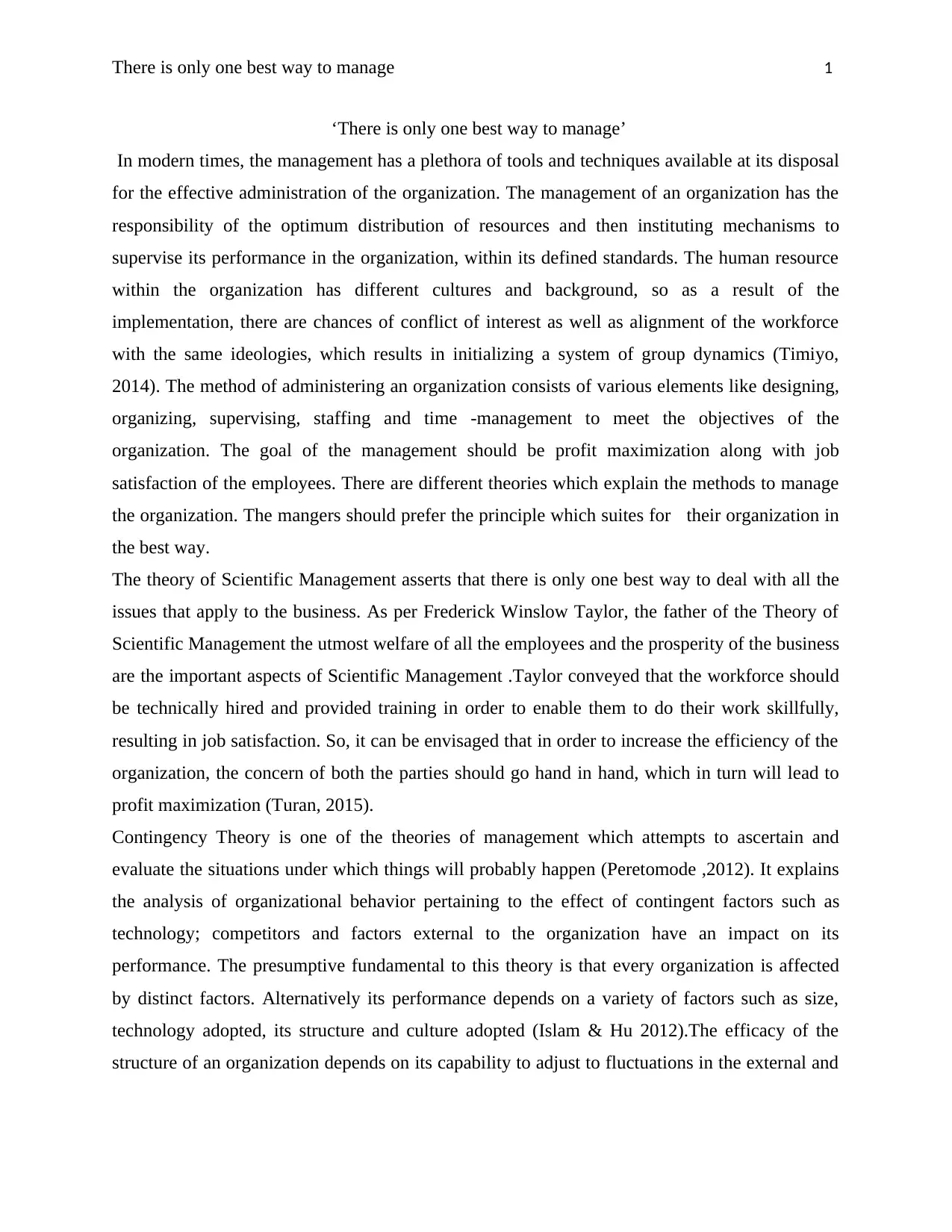
There is only one best way to manage 1
‘There is only one best way to manage’
In modern times, the management has a plethora of tools and techniques available at its disposal
for the effective administration of the organization. The management of an organization has the
responsibility of the optimum distribution of resources and then instituting mechanisms to
supervise its performance in the organization, within its defined standards. The human resource
within the organization has different cultures and background, so as a result of the
implementation, there are chances of conflict of interest as well as alignment of the workforce
with the same ideologies, which results in initializing a system of group dynamics (Timiyo,
2014). The method of administering an organization consists of various elements like designing,
organizing, supervising, staffing and time -management to meet the objectives of the
organization. The goal of the management should be profit maximization along with job
satisfaction of the employees. There are different theories which explain the methods to manage
the organization. The mangers should prefer the principle which suites for their organization in
the best way.
The theory of Scientific Management asserts that there is only one best way to deal with all the
issues that apply to the business. As per Frederick Winslow Taylor, the father of the Theory of
Scientific Management the utmost welfare of all the employees and the prosperity of the business
are the important aspects of Scientific Management .Taylor conveyed that the workforce should
be technically hired and provided training in order to enable them to do their work skillfully,
resulting in job satisfaction. So, it can be envisaged that in order to increase the efficiency of the
organization, the concern of both the parties should go hand in hand, which in turn will lead to
profit maximization (Turan, 2015).
Contingency Theory is one of the theories of management which attempts to ascertain and
evaluate the situations under which things will probably happen (Peretomode ,2012). It explains
the analysis of organizational behavior pertaining to the effect of contingent factors such as
technology; competitors and factors external to the organization have an impact on its
performance. The presumptive fundamental to this theory is that every organization is affected
by distinct factors. Alternatively its performance depends on a variety of factors such as size,
technology adopted, its structure and culture adopted (Islam & Hu 2012).The efficacy of the
structure of an organization depends on its capability to adjust to fluctuations in the external and
‘There is only one best way to manage’
In modern times, the management has a plethora of tools and techniques available at its disposal
for the effective administration of the organization. The management of an organization has the
responsibility of the optimum distribution of resources and then instituting mechanisms to
supervise its performance in the organization, within its defined standards. The human resource
within the organization has different cultures and background, so as a result of the
implementation, there are chances of conflict of interest as well as alignment of the workforce
with the same ideologies, which results in initializing a system of group dynamics (Timiyo,
2014). The method of administering an organization consists of various elements like designing,
organizing, supervising, staffing and time -management to meet the objectives of the
organization. The goal of the management should be profit maximization along with job
satisfaction of the employees. There are different theories which explain the methods to manage
the organization. The mangers should prefer the principle which suites for their organization in
the best way.
The theory of Scientific Management asserts that there is only one best way to deal with all the
issues that apply to the business. As per Frederick Winslow Taylor, the father of the Theory of
Scientific Management the utmost welfare of all the employees and the prosperity of the business
are the important aspects of Scientific Management .Taylor conveyed that the workforce should
be technically hired and provided training in order to enable them to do their work skillfully,
resulting in job satisfaction. So, it can be envisaged that in order to increase the efficiency of the
organization, the concern of both the parties should go hand in hand, which in turn will lead to
profit maximization (Turan, 2015).
Contingency Theory is one of the theories of management which attempts to ascertain and
evaluate the situations under which things will probably happen (Peretomode ,2012). It explains
the analysis of organizational behavior pertaining to the effect of contingent factors such as
technology; competitors and factors external to the organization have an impact on its
performance. The presumptive fundamental to this theory is that every organization is affected
by distinct factors. Alternatively its performance depends on a variety of factors such as size,
technology adopted, its structure and culture adopted (Islam & Hu 2012).The efficacy of the
structure of an organization depends on its capability to adjust to fluctuations in the external and
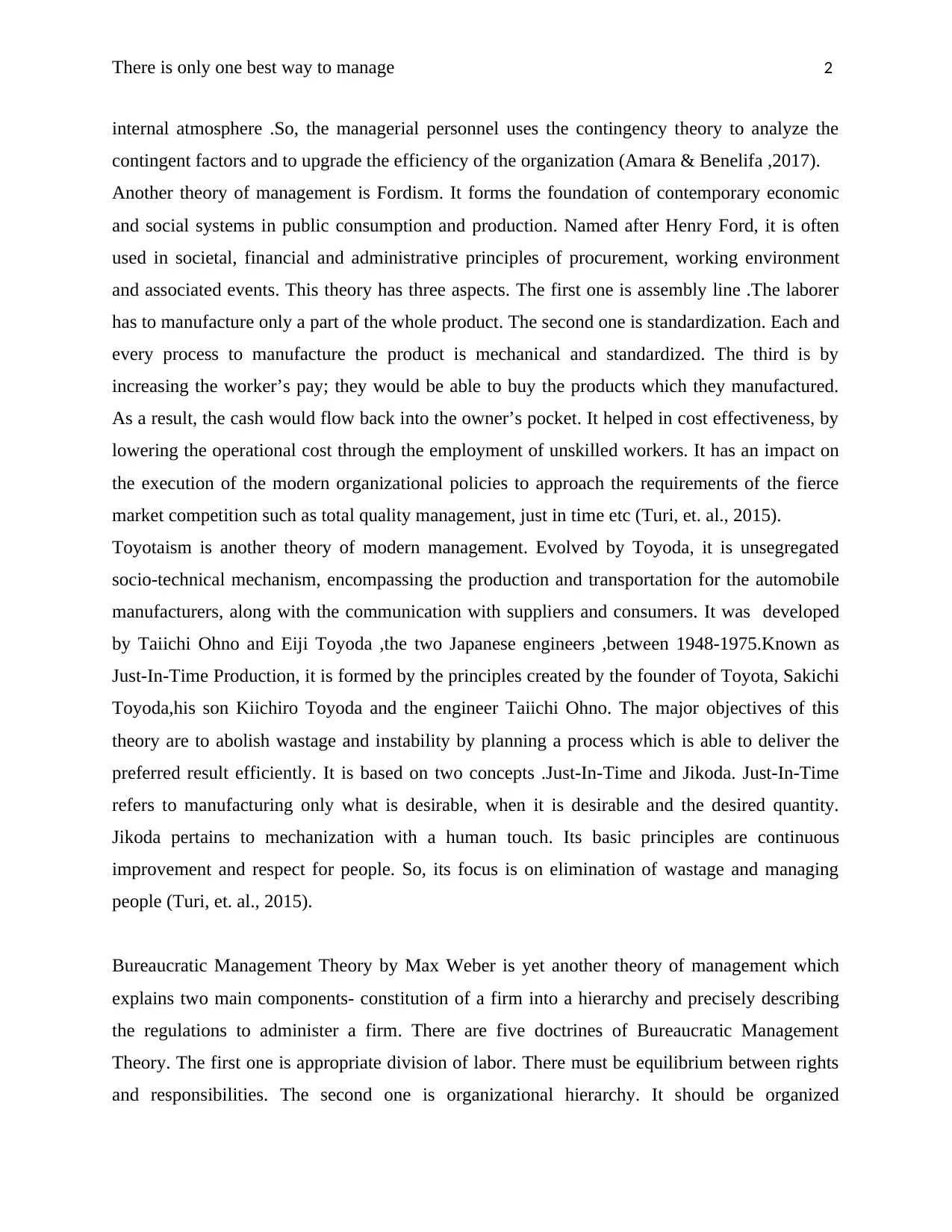
There is only one best way to manage 2
internal atmosphere .So, the managerial personnel uses the contingency theory to analyze the
contingent factors and to upgrade the efficiency of the organization (Amara & Benelifa ,2017).
Another theory of management is Fordism. It forms the foundation of contemporary economic
and social systems in public consumption and production. Named after Henry Ford, it is often
used in societal, financial and administrative principles of procurement, working environment
and associated events. This theory has three aspects. The first one is assembly line .The laborer
has to manufacture only a part of the whole product. The second one is standardization. Each and
every process to manufacture the product is mechanical and standardized. The third is by
increasing the worker’s pay; they would be able to buy the products which they manufactured.
As a result, the cash would flow back into the owner’s pocket. It helped in cost effectiveness, by
lowering the operational cost through the employment of unskilled workers. It has an impact on
the execution of the modern organizational policies to approach the requirements of the fierce
market competition such as total quality management, just in time etc (Turi, et. al., 2015).
Toyotaism is another theory of modern management. Evolved by Toyoda, it is unsegregated
socio-technical mechanism, encompassing the production and transportation for the automobile
manufacturers, along with the communication with suppliers and consumers. It was developed
by Taiichi Ohno and Eiji Toyoda ,the two Japanese engineers ,between 1948-1975.Known as
Just-In-Time Production, it is formed by the principles created by the founder of Toyota, Sakichi
Toyoda,his son Kiichiro Toyoda and the engineer Taiichi Ohno. The major objectives of this
theory are to abolish wastage and instability by planning a process which is able to deliver the
preferred result efficiently. It is based on two concepts .Just-In-Time and Jikoda. Just-In-Time
refers to manufacturing only what is desirable, when it is desirable and the desired quantity.
Jikoda pertains to mechanization with a human touch. Its basic principles are continuous
improvement and respect for people. So, its focus is on elimination of wastage and managing
people (Turi, et. al., 2015).
Bureaucratic Management Theory by Max Weber is yet another theory of management which
explains two main components- constitution of a firm into a hierarchy and precisely describing
the regulations to administer a firm. There are five doctrines of Bureaucratic Management
Theory. The first one is appropriate division of labor. There must be equilibrium between rights
and responsibilities. The second one is organizational hierarchy. It should be organized
internal atmosphere .So, the managerial personnel uses the contingency theory to analyze the
contingent factors and to upgrade the efficiency of the organization (Amara & Benelifa ,2017).
Another theory of management is Fordism. It forms the foundation of contemporary economic
and social systems in public consumption and production. Named after Henry Ford, it is often
used in societal, financial and administrative principles of procurement, working environment
and associated events. This theory has three aspects. The first one is assembly line .The laborer
has to manufacture only a part of the whole product. The second one is standardization. Each and
every process to manufacture the product is mechanical and standardized. The third is by
increasing the worker’s pay; they would be able to buy the products which they manufactured.
As a result, the cash would flow back into the owner’s pocket. It helped in cost effectiveness, by
lowering the operational cost through the employment of unskilled workers. It has an impact on
the execution of the modern organizational policies to approach the requirements of the fierce
market competition such as total quality management, just in time etc (Turi, et. al., 2015).
Toyotaism is another theory of modern management. Evolved by Toyoda, it is unsegregated
socio-technical mechanism, encompassing the production and transportation for the automobile
manufacturers, along with the communication with suppliers and consumers. It was developed
by Taiichi Ohno and Eiji Toyoda ,the two Japanese engineers ,between 1948-1975.Known as
Just-In-Time Production, it is formed by the principles created by the founder of Toyota, Sakichi
Toyoda,his son Kiichiro Toyoda and the engineer Taiichi Ohno. The major objectives of this
theory are to abolish wastage and instability by planning a process which is able to deliver the
preferred result efficiently. It is based on two concepts .Just-In-Time and Jikoda. Just-In-Time
refers to manufacturing only what is desirable, when it is desirable and the desired quantity.
Jikoda pertains to mechanization with a human touch. Its basic principles are continuous
improvement and respect for people. So, its focus is on elimination of wastage and managing
people (Turi, et. al., 2015).
Bureaucratic Management Theory by Max Weber is yet another theory of management which
explains two main components- constitution of a firm into a hierarchy and precisely describing
the regulations to administer a firm. There are five doctrines of Bureaucratic Management
Theory. The first one is appropriate division of labor. There must be equilibrium between rights
and responsibilities. The second one is organizational hierarchy. It should be organized
⊘ This is a preview!⊘
Do you want full access?
Subscribe today to unlock all pages.

Trusted by 1+ million students worldwide
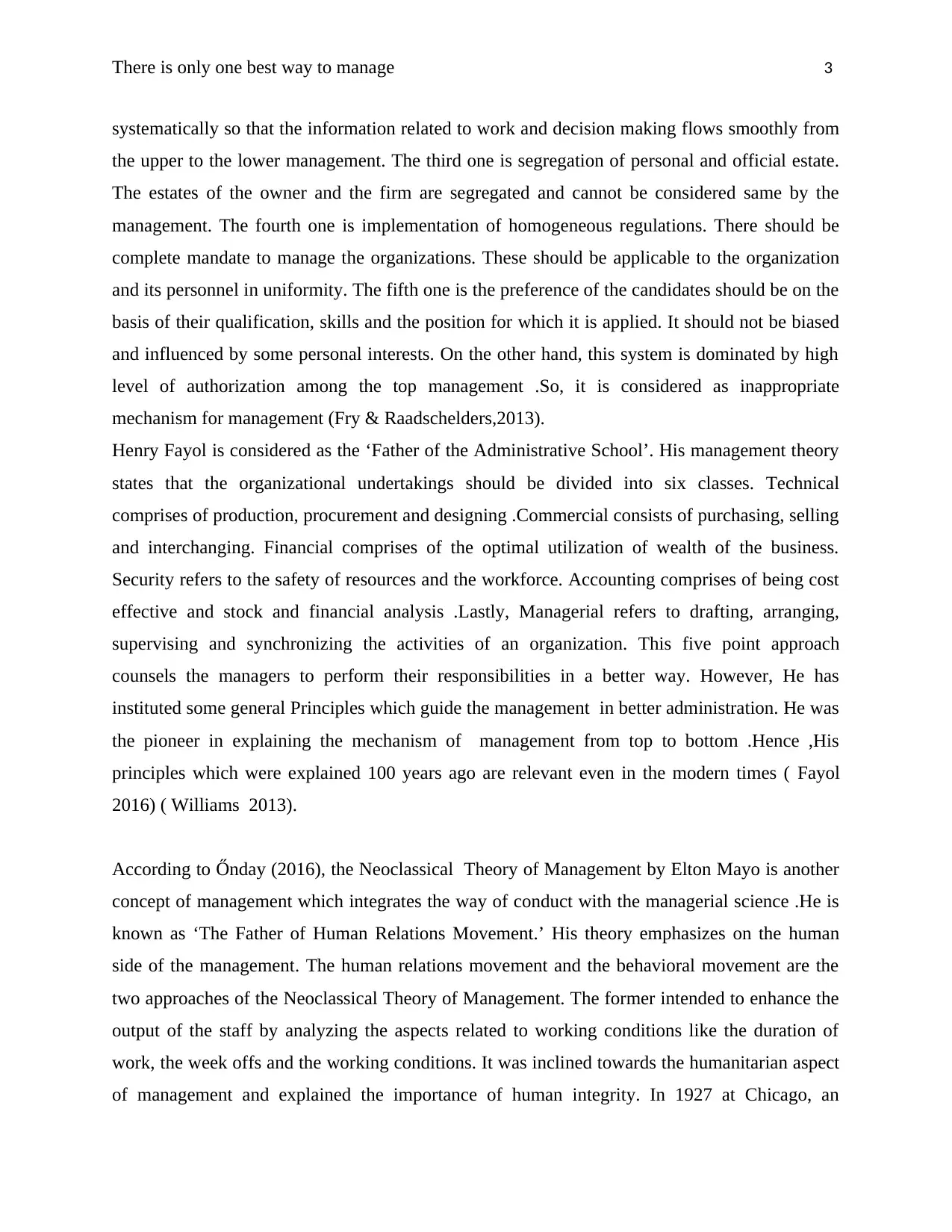
There is only one best way to manage 3
systematically so that the information related to work and decision making flows smoothly from
the upper to the lower management. The third one is segregation of personal and official estate.
The estates of the owner and the firm are segregated and cannot be considered same by the
management. The fourth one is implementation of homogeneous regulations. There should be
complete mandate to manage the organizations. These should be applicable to the organization
and its personnel in uniformity. The fifth one is the preference of the candidates should be on the
basis of their qualification, skills and the position for which it is applied. It should not be biased
and influenced by some personal interests. On the other hand, this system is dominated by high
level of authorization among the top management .So, it is considered as inappropriate
mechanism for management (Fry & Raadschelders,2013).
Henry Fayol is considered as the ‘Father of the Administrative School’. His management theory
states that the organizational undertakings should be divided into six classes. Technical
comprises of production, procurement and designing .Commercial consists of purchasing, selling
and interchanging. Financial comprises of the optimal utilization of wealth of the business.
Security refers to the safety of resources and the workforce. Accounting comprises of being cost
effective and stock and financial analysis .Lastly, Managerial refers to drafting, arranging,
supervising and synchronizing the activities of an organization. This five point approach
counsels the managers to perform their responsibilities in a better way. However, He has
instituted some general Principles which guide the management in better administration. He was
the pioneer in explaining the mechanism of management from top to bottom .Hence ,His
principles which were explained 100 years ago are relevant even in the modern times ( Fayol
2016) ( Williams 2013).
According to Őnday (2016), the Neoclassical Theory of Management by Elton Mayo is another
concept of management which integrates the way of conduct with the managerial science .He is
known as ‘The Father of Human Relations Movement.’ His theory emphasizes on the human
side of the management. The human relations movement and the behavioral movement are the
two approaches of the Neoclassical Theory of Management. The former intended to enhance the
output of the staff by analyzing the aspects related to working conditions like the duration of
work, the week offs and the working conditions. It was inclined towards the humanitarian aspect
of management and explained the importance of human integrity. In 1927 at Chicago, an
systematically so that the information related to work and decision making flows smoothly from
the upper to the lower management. The third one is segregation of personal and official estate.
The estates of the owner and the firm are segregated and cannot be considered same by the
management. The fourth one is implementation of homogeneous regulations. There should be
complete mandate to manage the organizations. These should be applicable to the organization
and its personnel in uniformity. The fifth one is the preference of the candidates should be on the
basis of their qualification, skills and the position for which it is applied. It should not be biased
and influenced by some personal interests. On the other hand, this system is dominated by high
level of authorization among the top management .So, it is considered as inappropriate
mechanism for management (Fry & Raadschelders,2013).
Henry Fayol is considered as the ‘Father of the Administrative School’. His management theory
states that the organizational undertakings should be divided into six classes. Technical
comprises of production, procurement and designing .Commercial consists of purchasing, selling
and interchanging. Financial comprises of the optimal utilization of wealth of the business.
Security refers to the safety of resources and the workforce. Accounting comprises of being cost
effective and stock and financial analysis .Lastly, Managerial refers to drafting, arranging,
supervising and synchronizing the activities of an organization. This five point approach
counsels the managers to perform their responsibilities in a better way. However, He has
instituted some general Principles which guide the management in better administration. He was
the pioneer in explaining the mechanism of management from top to bottom .Hence ,His
principles which were explained 100 years ago are relevant even in the modern times ( Fayol
2016) ( Williams 2013).
According to Őnday (2016), the Neoclassical Theory of Management by Elton Mayo is another
concept of management which integrates the way of conduct with the managerial science .He is
known as ‘The Father of Human Relations Movement.’ His theory emphasizes on the human
side of the management. The human relations movement and the behavioral movement are the
two approaches of the Neoclassical Theory of Management. The former intended to enhance the
output of the staff by analyzing the aspects related to working conditions like the duration of
work, the week offs and the working conditions. It was inclined towards the humanitarian aspect
of management and explained the importance of human integrity. In 1927 at Chicago, an
Paraphrase This Document
Need a fresh take? Get an instant paraphrase of this document with our AI Paraphraser
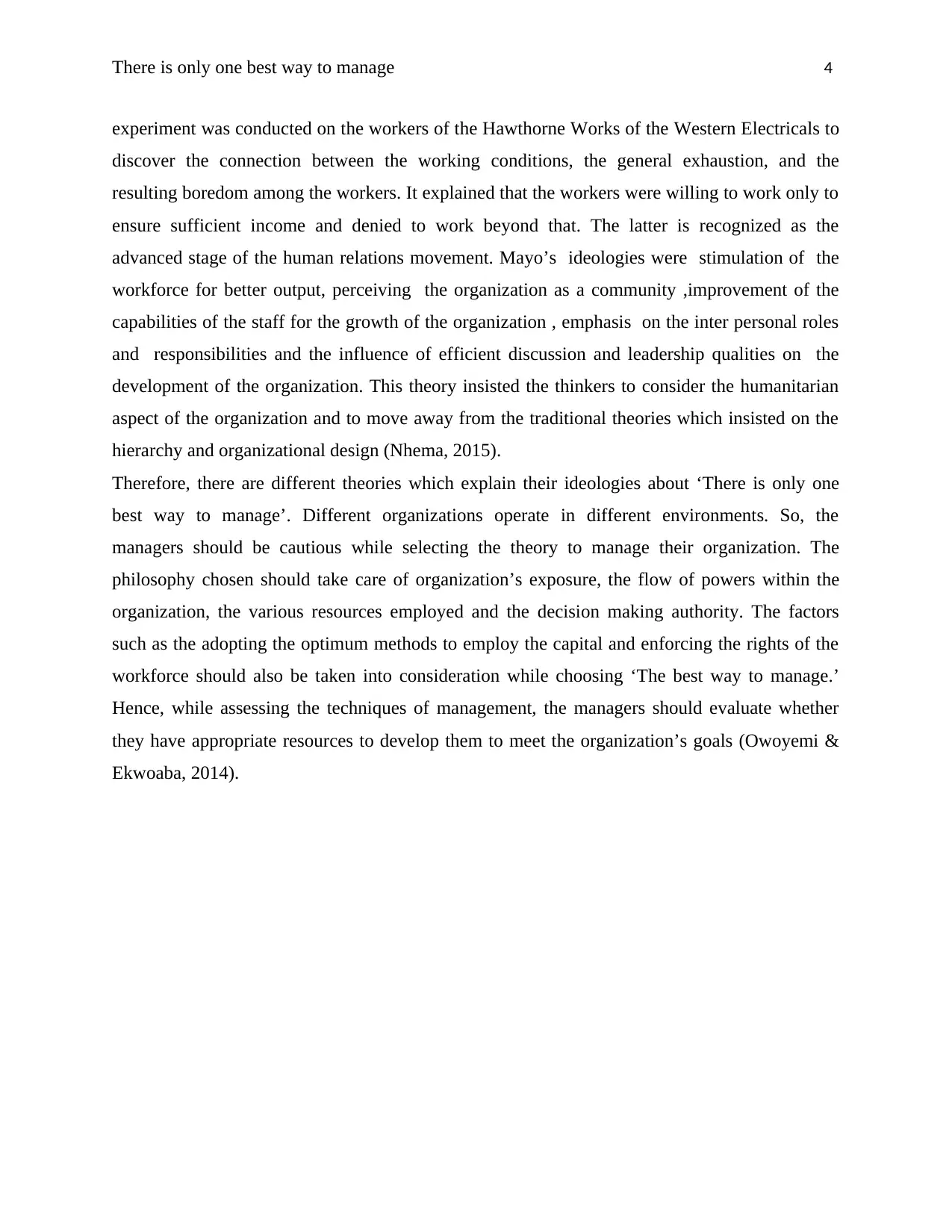
There is only one best way to manage 4
experiment was conducted on the workers of the Hawthorne Works of the Western Electricals to
discover the connection between the working conditions, the general exhaustion, and the
resulting boredom among the workers. It explained that the workers were willing to work only to
ensure sufficient income and denied to work beyond that. The latter is recognized as the
advanced stage of the human relations movement. Mayo’s ideologies were stimulation of the
workforce for better output, perceiving the organization as a community ,improvement of the
capabilities of the staff for the growth of the organization , emphasis on the inter personal roles
and responsibilities and the influence of efficient discussion and leadership qualities on the
development of the organization. This theory insisted the thinkers to consider the humanitarian
aspect of the organization and to move away from the traditional theories which insisted on the
hierarchy and organizational design (Nhema, 2015).
Therefore, there are different theories which explain their ideologies about ‘There is only one
best way to manage’. Different organizations operate in different environments. So, the
managers should be cautious while selecting the theory to manage their organization. The
philosophy chosen should take care of organization’s exposure, the flow of powers within the
organization, the various resources employed and the decision making authority. The factors
such as the adopting the optimum methods to employ the capital and enforcing the rights of the
workforce should also be taken into consideration while choosing ‘The best way to manage.’
Hence, while assessing the techniques of management, the managers should evaluate whether
they have appropriate resources to develop them to meet the organization’s goals (Owoyemi &
Ekwoaba, 2014).
experiment was conducted on the workers of the Hawthorne Works of the Western Electricals to
discover the connection between the working conditions, the general exhaustion, and the
resulting boredom among the workers. It explained that the workers were willing to work only to
ensure sufficient income and denied to work beyond that. The latter is recognized as the
advanced stage of the human relations movement. Mayo’s ideologies were stimulation of the
workforce for better output, perceiving the organization as a community ,improvement of the
capabilities of the staff for the growth of the organization , emphasis on the inter personal roles
and responsibilities and the influence of efficient discussion and leadership qualities on the
development of the organization. This theory insisted the thinkers to consider the humanitarian
aspect of the organization and to move away from the traditional theories which insisted on the
hierarchy and organizational design (Nhema, 2015).
Therefore, there are different theories which explain their ideologies about ‘There is only one
best way to manage’. Different organizations operate in different environments. So, the
managers should be cautious while selecting the theory to manage their organization. The
philosophy chosen should take care of organization’s exposure, the flow of powers within the
organization, the various resources employed and the decision making authority. The factors
such as the adopting the optimum methods to employ the capital and enforcing the rights of the
workforce should also be taken into consideration while choosing ‘The best way to manage.’
Hence, while assessing the techniques of management, the managers should evaluate whether
they have appropriate resources to develop them to meet the organization’s goals (Owoyemi &
Ekwoaba, 2014).
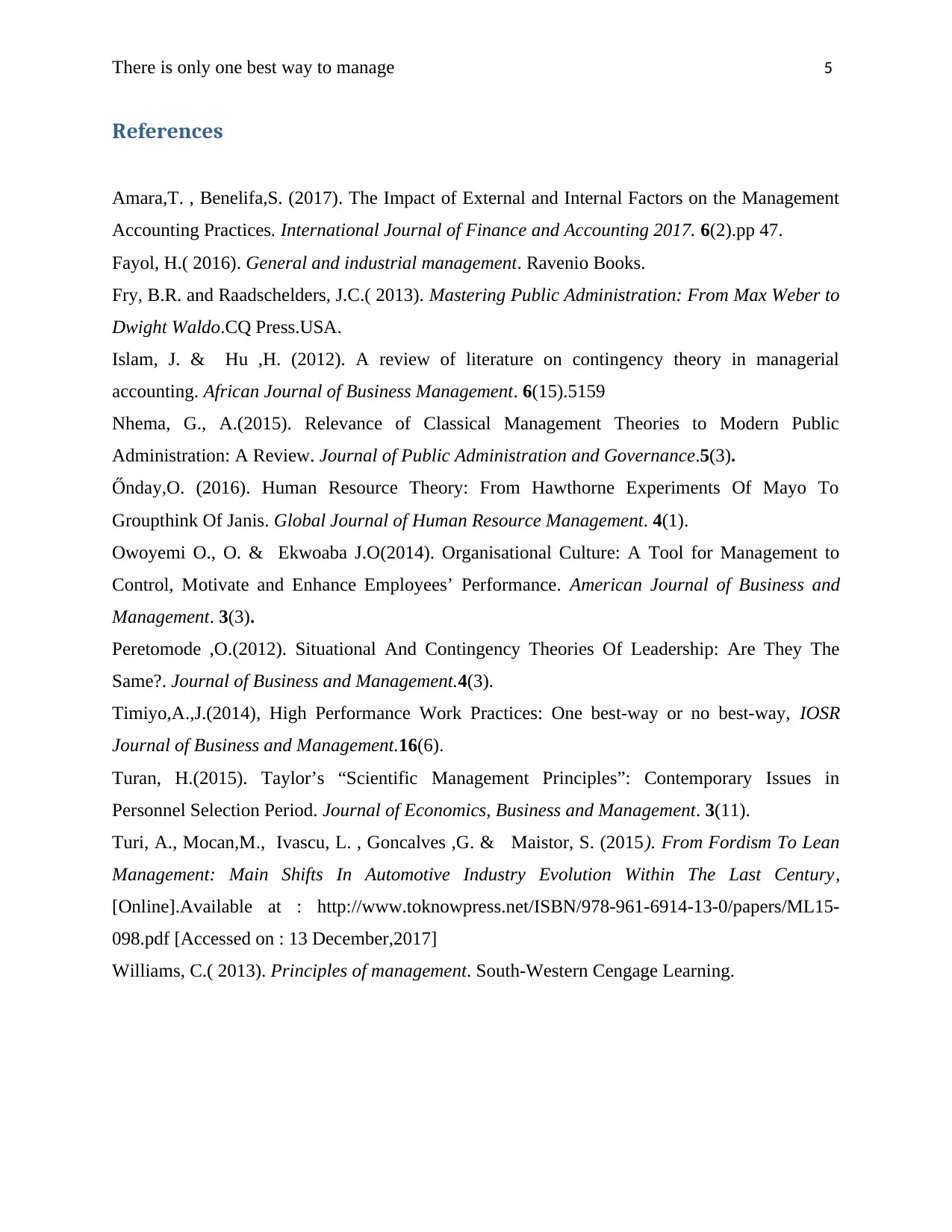
There is only one best way to manage 5
References
Amara,T. , Benelifa,S. (2017). The Impact of External and Internal Factors on the Management
Accounting Practices. International Journal of Finance and Accounting 2017. 6(2).pp 47.
Fayol, H.( 2016). General and industrial management. Ravenio Books.
Fry, B.R. and Raadschelders, J.C.( 2013). Mastering Public Administration: From Max Weber to
Dwight Waldo.CQ Press.USA.
Islam, J. & Hu ,H. (2012). A review of literature on contingency theory in managerial
accounting. African Journal of Business Management. 6(15).5159
Nhema, G., A.(2015). Relevance of Classical Management Theories to Modern Public
Administration: A Review. Journal of Public Administration and Governance.5(3).
Őnday,O. (2016). Human Resource Theory: From Hawthorne Experiments Of Mayo To
Groupthink Of Janis. Global Journal of Human Resource Management. 4(1).
Owoyemi O., O. & Ekwoaba J.O(2014). Organisational Culture: A Tool for Management to
Control, Motivate and Enhance Employees’ Performance. American Journal of Business and
Management. 3(3).
Peretomode ,O.(2012). Situational And Contingency Theories Of Leadership: Are They The
Same?. Journal of Business and Management.4(3).
Timiyo,A.,J.(2014), High Performance Work Practices: One best-way or no best-way, IOSR
Journal of Business and Management.16(6).
Turan, H.(2015). Taylor’s “Scientific Management Principles”: Contemporary Issues in
Personnel Selection Period. Journal of Economics, Business and Management. 3(11).
Turi, A., Mocan,M., Ivascu, L. , Goncalves ,G. & Maistor, S. (2015). From Fordism To Lean
Management: Main Shifts In Automotive Industry Evolution Within The Last Century,
[Online].Available at : http://www.toknowpress.net/ISBN/978-961-6914-13-0/papers/ML15-
098.pdf [Accessed on : 13 December,2017]
Williams, C.( 2013). Principles of management. South-Western Cengage Learning.
References
Amara,T. , Benelifa,S. (2017). The Impact of External and Internal Factors on the Management
Accounting Practices. International Journal of Finance and Accounting 2017. 6(2).pp 47.
Fayol, H.( 2016). General and industrial management. Ravenio Books.
Fry, B.R. and Raadschelders, J.C.( 2013). Mastering Public Administration: From Max Weber to
Dwight Waldo.CQ Press.USA.
Islam, J. & Hu ,H. (2012). A review of literature on contingency theory in managerial
accounting. African Journal of Business Management. 6(15).5159
Nhema, G., A.(2015). Relevance of Classical Management Theories to Modern Public
Administration: A Review. Journal of Public Administration and Governance.5(3).
Őnday,O. (2016). Human Resource Theory: From Hawthorne Experiments Of Mayo To
Groupthink Of Janis. Global Journal of Human Resource Management. 4(1).
Owoyemi O., O. & Ekwoaba J.O(2014). Organisational Culture: A Tool for Management to
Control, Motivate and Enhance Employees’ Performance. American Journal of Business and
Management. 3(3).
Peretomode ,O.(2012). Situational And Contingency Theories Of Leadership: Are They The
Same?. Journal of Business and Management.4(3).
Timiyo,A.,J.(2014), High Performance Work Practices: One best-way or no best-way, IOSR
Journal of Business and Management.16(6).
Turan, H.(2015). Taylor’s “Scientific Management Principles”: Contemporary Issues in
Personnel Selection Period. Journal of Economics, Business and Management. 3(11).
Turi, A., Mocan,M., Ivascu, L. , Goncalves ,G. & Maistor, S. (2015). From Fordism To Lean
Management: Main Shifts In Automotive Industry Evolution Within The Last Century,
[Online].Available at : http://www.toknowpress.net/ISBN/978-961-6914-13-0/papers/ML15-
098.pdf [Accessed on : 13 December,2017]
Williams, C.( 2013). Principles of management. South-Western Cengage Learning.
⊘ This is a preview!⊘
Do you want full access?
Subscribe today to unlock all pages.

Trusted by 1+ million students worldwide
1 out of 6
Related Documents
Your All-in-One AI-Powered Toolkit for Academic Success.
+13062052269
info@desklib.com
Available 24*7 on WhatsApp / Email
![[object Object]](/_next/static/media/star-bottom.7253800d.svg)
Unlock your academic potential
Copyright © 2020–2025 A2Z Services. All Rights Reserved. Developed and managed by ZUCOL.




